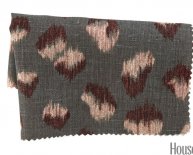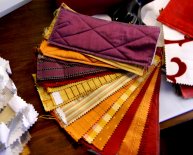
Recycled Fleece
 I’m a lover of natural fibers, too. And they have their place in my closet. But truth be told, when it comes to dealing with climates that are extreme and inclement nothing compares to outerwear built with a nylon laminate water-proof breathable construction. Yet there’s no doubt that the polymers and chemicals involved in creating these fabrics are not doing wonders for the environment. That’s why some companies are making poly fabrics from recycled materials and more importantly from facilities that treat their waste water. It’s cutting down on the use of virgin plastic to some extent, which is making a positive impact.
I’m a lover of natural fibers, too. And they have their place in my closet. But truth be told, when it comes to dealing with climates that are extreme and inclement nothing compares to outerwear built with a nylon laminate water-proof breathable construction. Yet there’s no doubt that the polymers and chemicals involved in creating these fabrics are not doing wonders for the environment. That’s why some companies are making poly fabrics from recycled materials and more importantly from facilities that treat their waste water. It’s cutting down on the use of virgin plastic to some extent, which is making a positive impact.
According to some estimates, 65% of the fabrics manufactured worldwide are synthetic. And I know from my research on micro-plastics we’re finding on the world’ most remote beaches those synthetic fibers are being shed into our environment through our gray water at an alarming rate. But that’ll be the subject of a later post.
 Like anything, the synthetic fabrics I rely upon certainly don’t last in operable condition forever, and eventually they need to be discarded. Yet I don’t want to send them to the landfill. Are synthetic fabrics recyclable? Yes, but like all plastics, their recycling is not a closed loop process and they cannot be recycled over and over again.
Like anything, the synthetic fabrics I rely upon certainly don’t last in operable condition forever, and eventually they need to be discarded. Yet I don’t want to send them to the landfill. Are synthetic fabrics recyclable? Yes, but like all plastics, their recycling is not a closed loop process and they cannot be recycled over and over again.
There are basically 2 types of textile recycling: fiber recycling and polymer recycling. Fiber recycling means your garment is shredded back into fibers that are typically blended with new fibers to make a new yarn for new garments or carpets. Polymer recycling is typically used with polyesters that are shredded and ultimately melted down and turned into plastic pellets that are then are respun into fibers for new polyester applications.
Polyester recycling, one might say, does make a dent in the amount if virgin plastics, or fossil fuels, used in future polyester production. According to The Textile Exchange, “The production of polyester fibers accounts for about 40-45% of total global annual fiber production. Polyester is made from petroleum-based chemicals; its raw material is crude oil, which is the same source as gasoline. Polyester production involves a number of different processes, including refining the oil, breaking it into chemicals, and creating the polyethylene terephthalate (PET) polymer, which is then extruded and spun into polyester fibers. Polyester production is energy-intensive and relies on a finite, non-renewable natural resource that we utilize in many other ways as part of everyday life for energy, fuel, and plastics production. About 65-70 percent of global polyester production is used for textiles, of which more than 65 percent is produced in China. The majority of the remaining 25-30 percent is used in the manufacture of PET beverage bottles.”
Polyester production involves a number of different processes, including refining the oil, breaking it into chemicals, and creating the polyethylene terephthalate (PET) polymer, which is then extruded and spun into polyester fibers. Polyester production is energy-intensive and relies on a finite, non-renewable natural resource that we utilize in many other ways as part of everyday life for energy, fuel, and plastics production. About 65-70 percent of global polyester production is used for textiles, of which more than 65 percent is produced in China. The majority of the remaining 25-30 percent is used in the manufacture of PET beverage bottles.”
This little known fact, that more PET goes into the production of polyester fabrics worldwide than plastic bottles, gives us some perspective. We all know of the plastic bottle campaigns to wean people off consuming single-use water bottles. But if there’s more plastic going into the manufacture of polyester fabrics, we need to up our campaigns to get more people to recycle their polyester and blended synthetic fabrics. (Needless to say, we might also want to consider using more natural fibers like wool when possible. But if I’m climbing rock and ice at 24, 000 feet, cotton has no place on my body. )
 85% of all textile waste goes to landfills and according to the EPA an astounding 68 lbs per person heads to the landfill each year. So, what can we do, individually, to reduce our textile waste in general? Here are 3 steps that’ll help you do some good:
85% of all textile waste goes to landfills and according to the EPA an astounding 68 lbs per person heads to the landfill each year. So, what can we do, individually, to reduce our textile waste in general? Here are 3 steps that’ll help you do some good:
1) Be aware of the plastic-content in the fabrics you’re buying and where they will end up at the end of their so-called “life.” I’m excited that The North Face has a new recycling program for all fabrics, including synthetic fabrics found in your outerwear like Goretex jackets, your fleece, and down sweaters. Their Clothes the Loop bins, now found in 10 of their stores, enable you to recycle those garments and get $10 off your next purchase. The synthetic fabrics are turned into new uses like insulation, foam board in the backs of cars, and bricks made of dust.
 2) Even your rags should be recycled. Don’t be shy about passing on your totally worn-out, ripped and torn togs to your textile recycler or the Clothes the Loop bin. Any non-wearable garments will be shredded in the end so they’re happy to take your scraps.
2) Even your rags should be recycled. Don’t be shy about passing on your totally worn-out, ripped and torn togs to your textile recycler or the Clothes the Loop bin. Any non-wearable garments will be shredded in the end so they’re happy to take your scraps.
3) Reuse: If you don’t have a Clothes the Loop bin near you and you have clothing that can still be worn, consider donating it to a worthy organization nearby like Good Will and the Salvation Army or a local homeless shelter. There’s a great national resource called Donationtown that can help you find the nearest charity that will take your still-in-decent-condition clothing to distribute to those in need. They’ll even come and pick your clothing up.
In our family, we pass on our really warm outerwear to families we know in villages in the high Himalaya who will benefit greatly from receiving a down jacket or child’s snow suit. If you do whatever you can to keep the good clothes in circulation, you’ll be helping to reduce our overall textile waste, worldwide.

















